Walter Crane
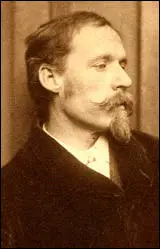
Walter Crane was born in Liverpool on 15th August, 1845. Walter's father, Thomas Crane, was a moderately successful portrait painter. When he was a child the family lived in Torquay. (1)
Crane took a keen interest in art as a child and according to Rodney K. Engen "as a boy, Crane worked in his father's studio sketching the hands and faces of his father's portrait commissions". (2)
In his autobiography Crane pointed out: "My early experiments with the pencil - and I never remember being without one of some kind - procured for me a certain local repute among our neighbours and acquaintances... I picked up in my father's studio and under
his eye a variety of artistic knowledge in an unsystematic way. I was always drawing, and any reading, or looking at prints or pictures, led back to drawing again." (3)
In 1851 the family moved to London with the hope that this would provide Crane with more clients. Unfortunately, just as business was improving, Thomas Crane died. Soon after his father's death Walter Crane obtained an apprenticeship with William James Linton who ran an engraving shop. (4)
Linton was an active member of the Chartist movement and been co-editor of its newspaper, Cause of the People, with George Jacob Holyoake. Linton was one of the leaders of Moral Force movement. Edward Royle has pointed out that Linton's "belief in equality - and women were not excluded - and optimism concerning the improvability and intelligence of the human race, together with the conviction that the whole nation required the free participation of all citizens, underpinned the case for moral force Chartism." (5)
Crane later recalled: "W. J. Linton was in appearance small of stature, but a very remarkable-looking man. His fair hair, rather fine and thin, fell in actual locks to his shoulders, and he wore a long flowing beard and moustache, then beginning to be tinged with grey... He had abundance of nervous energy and moved with a quick, rapid step, coming into the office with a sort of breezy rush, bringing with him always a stimulating sense of vitality. He spoke rapidly in a light-toned voice, frequently punctuated with a curious dry, obstructed sort of laugh. Altogether a kindly, generous, impulsive, and enthusiastic nature, a true socialist at heart, with an ardent love of liberty and with much of the revolutionary feeling of 1848 about him." (6)
Walter Crane: Successful Illustrator
Linton's stories of the struggle for parliamentary reform, had an important influence on Crane's early political development. As it was with another of Linton's students, William Luson Thomas, the founder of the weekly radical newspaper, The Graphic.
Linton was impressed by the quality of Crane's work and helped to find him commissions. This included providing the illustrations for a book being planned by John R. Wise. Crane went to live with Wise for six weeks while he was working on the pictures for The New Forest: its History and its Scenery (1862). Wise had radical political and religious opinions and introduced Crane to the work of John Stuart Mill and Percy Bysshe Shelley. (7)
William James Linton introduced Crane to John Ruskin: "I was at last actually in the presence of the great man - and I am sure he had no more enthusiastic admirer and devoted follower at that time than the youth of fifteen in Linton's office. In appearance Mr. Ruskin at that time was still like that early remarkable full-length portrait by Millais, though perhaps nearer to Herkomer's fine water-colour head of him, before he grew a beard. I recall his tall thin figure with a slight stoop, and his quiet, rather abstracted manner. He looked like an old-fashioned type of country gentleman with literary tastes, and wore the high velvet-collared coat one sees in his early portraits". (8)
Jeff A. Menges has pointed out: "Linton, recognizing Crane's imaginative passion, provided the youth with creative outlets. The apprenticeship served Crane's future in many ways - he had grained an insight into printing processes, which gave him a technical advantage when considering methods to improve upon the reproduction of his work with Linton. And it gave Crane on understanding of craftsmanship, which would become increasingly important to him later on in life - when Crane felt it had begun to dwindle from the materials consumed and produced in Victorian England." (9)
Walter Crane was very impressed with cartoonists such as John Leech and John Tenniel who worked for Punch Magazine. At the time "John Leech and Tenniel were then the chief supporters of Punch and often, during the dinner-hour, I used to wander through the Temple and out into Fleet Street, and study the cartoons displayed in the window of the old Punch office at No. 185." He also liked the work of the illustrator Charles Keene. (10)
Crane was asked to contribute illustrations to a series of books for very young children, nursery rhymes and fairy tales, to be printed by Edmund Evans, the leading woodblock colour printer in London, and published by Routledge. Over the next ten years Crane illustrated thirty-seven of these Toy Books, as they were known. These early drawings were influenced by his study of some Japenese prints he had discovered. (11)
His biographer, Alan Crawford, argues: "After the first nine his work began to emulate Japanese prints, with decorative compositions in flat, or very deep, perspective; and he began to furnish his pictures with the fashions and domestic bric-à-brac of the aesthetic movement... Nursery rhymes and fairy tales are full of pigs going to market and dishes eloping with spoons. Crane had a taste for such fantasy, especially the anthropomorphic animals - was his name not a bird? His peculiar sensibility wedged animal lunacy up against high fashion." (12)
Political Activist
In 1865 Walter Crane saw Work, a painting by Ford Madox Brown, at an art gallery in Piccadilly. The picture, shows the historian, Thomas Carlyle, and the leader of the Christian Socialist movement, F. D. Maurice, observing a group of men working. The painting marked an important development in British art because for the first time an artist had decided that a working man was a subject worth painting. Although Brown's painting did not immediately influence Crane's work, it had a profound impact on his long-term career. (13)
In the 1860s Crane began to take an active interest in politics. He was a supporter of the Liberal Party and some of their more radical politicians such as John Stuart Mill, John Bright, Henry Fawcett and William Gladstone and campaigned for the 1867 Reform Act. He especially was taken by Mill who represented Westminster in the House of Commons. "The same sort of men were returned to Parliament, with a few notable exceptions, such as that of John Stuart Mill, who sat in the new Parliament as member for Westminster. I recall seeing and hearing him at one of the many big political meetings at St. James's Hall during the period of the Reform agitation. Gentle - mannered, small and spare of figure, but of a very marked intellectual aspect, and great earnestness, he spoke in what truly might be described as a still small voice. Philosopher and recluse, it was extraordinary the enthusiasm he evoked, standing, too, as he did for all sorts of advanced and unpopular opinions." (14)
Walter Crane married Mary Frances Andrews on 6th September 1871. They spent the next eighteen months in Italy, where he painted portraits, landscapes as well as continuing with his book illustrations. He had paintings accepted by the Royal Academy and had several exhibitions in London art galleries. According to his biographer, Alan Crawford, "Crane produced... allegorical paintings.... almost all his life, giving them such titles as The Bridge of Life and The Roll of Fate, and he valued them above his other work. It was his ambition to show them at the Royal Academy, but he showed there only once after 1862. Instead they appeared each year at the Dudley and the Grosvenor and other London galleries, never to any acclaim. That was hard to bear, and the success of his children's books put salt in the wound. The public acclaimed him as ‘the academician of the nursery', but he wanted to be known as a distinguished allegorical painter. (15)
Crane became close friends with William Morris. The two men both deplored the effects of modern manufacturing and the commercial system of craftsmanship and design. Deeply influenced by Morris's pamphlet Art & Socialism, Crane became involved in both the Art Workers' Guild and the Arts and Crafts Society. Like Morris, Crane created designs for wallpapers, printed fabrics, tiles and ceramics. (16)
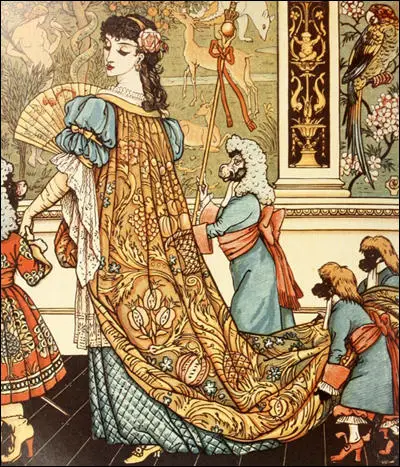
Morris talked to him a lot about history. He argued that John Ball and the Peasants' Revolt were early socialists. His intense earnestness and profound conviction set one thinking, however, and to a mind already more or less prepared by the economic writings of John Ruskin, and possessed of Radical sympathies in politics of long standing, it was not difficult to advance farther, even though such advance involved some divergence from the main road of contemporary thought." (17)
Social Democratic Federation
In January 1884, Crane and Morris joined the Social Democratic Federation (SDF). Its leader, H. M. Hyndman, had been converted to socialism by reading the work of Karl Marx. Other significant members included, Tom Mann, John Burns, Eleanor Marx, William Morris, George Lansbury, Edward Aveling, H. H. Champion, Theodore Rothstein, Helen Taylor, John Scurr, Guy Aldred, Dora Montefiore, Frank Harris, Clara Codd, John Spargo and Ben Tillett. (18)
Crane contributed illustrations for the party journal Justice that was edited by Henry Hyde Champion. As he later explained that he agreed to work for free as "all the work on the journal was gratuitous, from the writers of the articles to the compositors and printers." In one of his most popular drawings: "Capitalism was represented as a vampire fastening on a slumbering workman, and an emblematic figure of Socialism endeavours to arouse him to a sense of his danger by the blast of a clarion." (19)
It has been claimed that Crane "placed his talent at the disposal of the movement" and produced "membership cards, logos, cartoons, invitation cards, posters and illustrations." John Gorman argues that it was "Walter Crane's cartoons, his black and white illustrations and engravings... that shaped the imagery of socialism on trade union banners for thirty years". (20)
Crane, like Morris, found the SDF's leader, Hyndman, difficult. Crane shared Hyndman's Marxist beliefs, but objected to his nationalism and the dictatorial methods he used to run the party. Despite their poor relationship, Hyndman respected Crane as an artist: "Nobody, not even William Morris, did more to make Art a direct helpmate to the Socialist propaganda. Nobody has had a greater influence on the minds of doubters who feared that Socialism must be remote from and even destructive of the sense of beauty." (21)
Crane became associating with other radicals living in London. He especially liked I met here Peter Kropotkin, the Russian anarchist. Crane wrote in his autobiography, An Artist's Reminiscences (1907): "Kropotkin... who had suffered so much for his opinions, and who has won universal respect and sympathy in this country, charming all who have had the pleasure of his acquaintance by his genial manners, his disinterested enthusiasm for the cause of humanity, and his peaceful but earnest propaganda in anarchist-communism, as well as his valuable sociological writings". (22)
At a meeting of the Social Democratic Federation executive on 28th December, 1884, there was a heated about Hyndman's leadership. Some members, including Walter Crane, William Morris, Eleanor Marx, Ernest Belfort Bax and Edward Aveling decided to leave the SDF and formed a new organisation called the Socialist League. The group also produced its own journal, Commonweal. However, Morris was disappointed by the slow growth of the organisation. After six months the Socialist League only had eight branches and 230 members. Morris wrote to a friend: "I am in low spirits about the prospects of our party, if I can dignify a little knot of men by such a word. You see we are such a few, and hard as we work we don't seem to pick up people." (23)
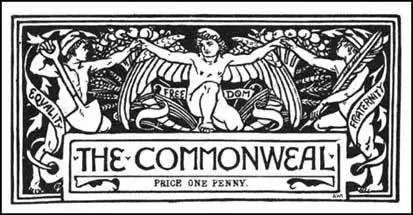
Although a Marxist, Crane hoped that socialism would be achieved through education rather than revolution. This is reflected in his decision to join the socialist debating group, the Fabian Society in October 1885. Other members included George Bernard Shaw, H. G. Wells, Sidney Webb, Beatrice Webb, Hubert Bland, Edward Pease, Havelock Ellis, Annie Besant, Graham Wallas and Frank Podmore. (24)
The children's author, Edith Nesbit, wrote to her friend, Ada Breakell about the group: "I should like to try and tell you a little about the Fabian Society - it's aim is to improve the social system - or rather to spread its news as to the possible improvements of the social system. There are about thirty members - some of whom are working men. We meet once a fortnight - and then someone reads a paper and we all talk about it. We are now going to issue a pamphlet." (25)
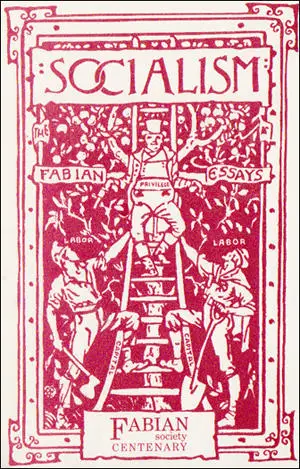
Crane agreed to give a lecture for the Fabian Society on socialism entitled Art and Commercialism. He was not a good lecturer and afterwards George Bernard Shaw remarked that Crane was only "bearable when he took up the chalk and showed what he meant on the blackboard". After this Crane tended to concentrate on doing art work for the society: "The Fabian Society certainly has done very useful educational work by its economic lectures and tracts. The Society has addressed itself more to the middle classes, and as regards Socialism has advocated a waiting or Fabian policy, relying rather on the effects of a gradual permeation of society by new ideas than emphatic protest and revolt." (26)
In 1885 exhibited his painting Angel of Freedom at the Grosvenor Gallery. It had been inspired by the poem, The Eve of Revolution, that had been written by Algernon Charles Swinburne. It has been pointed out by John Gorman, the author of Images of Labour (1985), that "Crane's Angel of Freedom... became a symbol of working class emancipation that was adapted in a hundred ways, copied and imitated throughout the labour movement and still survives today... His angel was to become a ready symbol for labour, heralding the future sunshine of the co-operative commonwealth." (27)
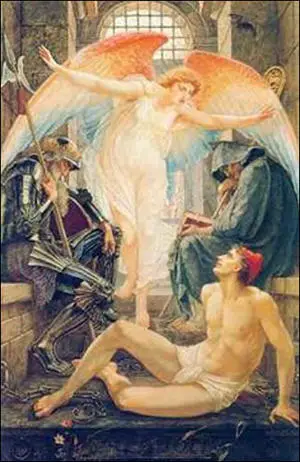
On 13th November, 1887 Walter Crane was involved with William Morris, H. H. Hyndman, Annie Besant, and John Burns in what became known as Bloody Sunday, when three people were killed and 200 injured during a public meeting in Trafalgar Square. Crane later recalled: "I never saw anything more like real warfare in my life - only the attack was all on one side. The police, in spite of their numbers, apparently thought they could not cope with the crowd. They had certainly exasperated them, and could not disperse them, as after every charge - and some of these drove the people right against the shutters in the shops in the Strand - they returned again." (28)
The following week, a friend, Alfred Linnell, was fatally injured during another protest demonstration and this event resulted in Morris writing, Death Song. Crane provided the cover drawing for this work. Crane, as a result of a suggestion made by his friend and fellow socialist, George F. Watts, provided twelve designs that illustrated heroic deeds carried out by working-class people. This included Alice Ayres, who died while rescuing three children from a fire, and two Paisley railway workers who were killed during an attempt to help others in trouble. This work was first shown at the Arts and Crafts Exhibition in 1890. (29)
Walter Crane became a close friend of Oscar Wilde, who also held socialist beliefs. Wilde, who was editor of Woman's World, commissioned him to provide illustrations for the magazine. In 1888 Crane also contributed three full-page illustrations for Wilde's highly successful book, The Happy Prince and Other Tales (30).
Socialist Imagery
In 1892 Walter Crane published his influential book, The Claims of Decorative Art, where he argued that art could not flourish in a world where wealth was so unfairly distributed. Crane claimed that only under "Socialism could Use and Beauty be united". The following year he was appointed director of design at Manchester School of Art. In 1898 he became principal of the Royal College of Art. His collected lectures were published in two books, The Bases of Design (1898) and Line and Form (1900).
Crane also attacked the impact of the industrial revolution on society: "Steam machinery, intended for the service of man and for the saving of human labour had under our economic system enslaved humanity instead, and become an engine for the production of profits, an express train in the race for wealth, only checked by the brake of what is called over-production. " (31)
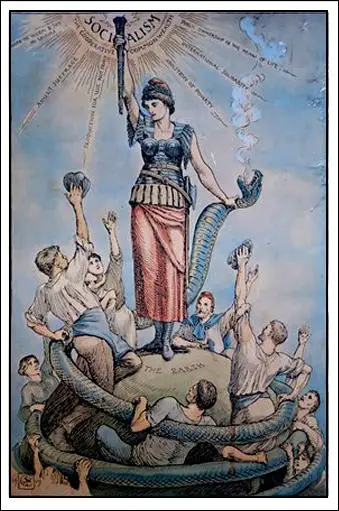
The Crane family moved to 13 Holland Street, off Kensington Church Street. "They lived a life of self-conscious bohemianism. The house was full of pewter and china, carved figures, Indian idols, a live alligator, model ships, a marmoset that slept in the fireplace, Crane's unsold paintings, all higgledy-piggledy and gathering dust. Amid all this Crane played the part of the artist, a small, dapper man with carefully curled moustaches and a little beard, a flowing yellow silk tie, and a velvet coat. Colleagues were apt to laugh at him, and they mostly thought his earliest works, the Toy Books, were the best. But he was a lovable figure, and they indulged his staginess. Both he and Mary Crane loved dressing up and they threw enormous parties." (32)
Walter Crane remained a committed socialist and a collection of Crane's political cartoons, Cartoons for the Cause, were published as a souvenir of the International and Trade Union Congress that met in London in 1896. He also supported the Labour Party when it was formed in 1900 and each May Day he would produce a poster for the organisation. Their purpose was, as Crane explained: "Directed to the embodiment of the principles of socialism and unmistakably inscribed with legends expressing the political aims and social aspirations of the party".
Crane's posters could be found "brightening the dreary walls of dingy meeting rooms" and in the homes of socialists: "Capitalism was a serpent, a wolf or a dragon; the workers were men of Morris's England, labourers and craftsmen, strong and determined, ever ready to slay the monster of evil, the capitalist system. Socialism was a sunny future, the millennium, almost but not quite within the eager grasp of a Phrygian-capped proletariat... The image of socialism bearing the torch, the banner of the keys of freedom was invariably a woman. Grecian robed, wearing the cap of liberty, sometimes graced with the wings of an angel, a heroine that was neither Britannia nor Joan of Arc yet encapsulated motherhood, beauty and courage... The influence of Crane's art upon the iconography of the working class movement was immense and nowhere was it in greater evidence than upon the giant silken banners of the trades unions that had their golden age during the last decade of the nineteenth century". (33)
Pacifism
Crane, like many socialists, believed that wars were often begun by capitalists for reasons of commerce than for idealism. In 1900 Crane joined with Ramsay MacDonald and Emmeline Pankhurst in resigning from the Fabian Society over its decision not to condemn the Boer War. Crane was a strong critic of the British Empire and after spending time with Annie Besant in India, wrote India Impressions (1907) that included severe criticisms of the way that the country was being ruled by the British.
Walter Crane published his autobiography, An Artist's Reminiscences in 1907. In the book he attempted to explain why he had spent so much of his life fighting for socialism: "Such experiences convinced me that freedom in any country is measured by the impunity with which unpopular opinions can be uttered - especially those advocating drastic political or social changes - or by the length of the tether of toleration, and that certain public rights may be won, but that they require constant vigilance to defend and maintain. It was a stormy period, and the bourgeois were in a panic, and the wildest ideas of Socialism were about. We were mis-represented and abused in every direction, and confused with the advocates of the use of dynamite." (34)
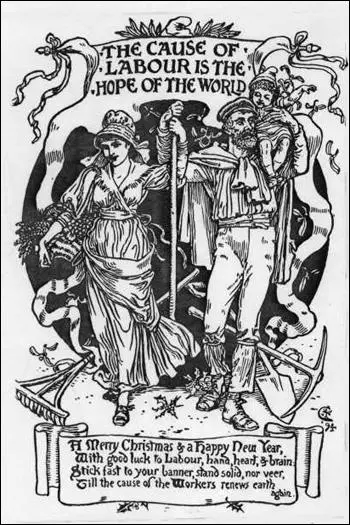
Crane's work during this period was to have a lasting impression on the art of the labour movement in Britain. Between the 1880s and the First World War, the socialist iconography developed by Crane can be seen on posters, pamphlets, membership cards and trade union banners. Crane's work was also widely circulated in Europe, and in Italy and Germany his reputation as an artist was greater than it was in England.
On 18th December 1914 Mary Crane was found dead on the railway line near Kingsnorth in Kent. The couple had been married for forty-four years and Crane was devastated by her death. Walter Crane died three months later in Horsham Hospital, on 14th March, 1915. (35)
Primary Sources
(1) Walter Crane, An Artist's Reminiscences (1907)
W. J. Linton was in appearance small of stature, but a very remarkable-looking man. His fair hair, rather fine and thin, fell in actual locks to his shoulders, and he wore a long flowing beard and moustache, then beginning to be tinged with grey. A keen, impulsive-looking, highly sensitive face with kindly blue eyes looked out under the unusually broad brim of a black "wideawake." He wore turn-down collars when the rest of the world mostly turned them up - a loose, continental-looking necktie, black velvet waistcoat, and a long-waisted coat of a very peculiar cut, having no traditional two buttons at the junction of the skirts at the back, trousers of an antique pattern belonging to the " forties," rather tight at the knees and falling over Wellington boots with small slits at the sides.
He had abundance of nervous energy and moved with a quick, rapid step, coming into the office with a sort of breezy rush, bringing with him always a stimulating sense of vitality. He spoke rapidly in a light-toned voice, frequently punctuated with a curious dry, obstructed sort of laugh. Altogether a kindly, generous, impulsive, and enthusiastic nature, a true socialist at heart, with an ardent love of liberty and with much of the revolutionary feeling of 1848 about him. He had a curious way of breaking off his sentences, leaving the listener to supply the last word.
He never obtruded his opinions, however, and such maxims as he may have given me at times were quite incontrovertible: such as, " A man cannot be a great man unless he is also a good man," which I recall his saying once; and on hearing about some people rather under a cloud through impecuniously, and not being able to pay their rent, he said, "They may be very good people, and yet not able to pay their rent." A gentle way, perhaps, of correcting bourgeois sentiment.
(2) Jeff A. Menges, The Art & Illustration of Walter Crane (2010)
Linton, recognizing Crane's imaginative passion, provided the youth with creative outlets. The apprenticeship served Crane's future in many ways - he had grained an insight into printing processes, which gave him a technical advantage when considering methods to improve upon the reproduction of his work with Linton. And it gave Crane on understanding of craftsmanship, which would become increasingly important to him later on in life - when Crane felt it had begun to dwindle from the materials consumed and produced in Victorian England.
(3) John Gorman, Images of Labour (1985)
Walter Crane's 'cartoons' were the popular art of the social-democratic movement, brightening the dreary walls of dingy meeting rooms, cheering cheerless homes and bringing the message of hope wherever a few workers gathered together to plan the social revolution. The imagery was always simple and compelling even when the drawings were elaborate. Capitalism was a serpent, a wolf or a dragon; the workers were men of Morris's England, labourers and craftsmen, strong and determined, ever ready to slay the monster of evil, the capitalist system. Socialism was a sunny future, the millennium, almost but not quite within the eager grasp of a Phrygian-capped proletariat...
The image of socialism bearing the torch, the banner of the keys of freedom was invariably a woman. Grecian robed, wearing the cap of liberty, sometimes graced with the wings of an angel, a heroine that was neither Britannia nor Joan of Arc yet encapsulated motherhood, beauty and courage... The influence of Crane's art upon the iconography of the working class movement was immense and nowhere was it in greater evidence than upon the giant silken banners of the trades unions that had their golden age during the last decade of the nineteenth century.
(4) Walter Crane, The Architecture of Art (18 February, 1887)
Steam machinery, intended for the service of man and for the saving of human labour had under our economic system enslaved humanity instead, and become an engine for the production of profits, an express train in the race for wealth, only checked by the brake of what is called over-production.
We want a vernacular in art. No mere verbal or formal agreement, or dead level of uniformity but that comprehensive and harmonizing unity with individual variety which can be developed among people politically and socially free.
(5) Walter Crane, The New Era (1895)
Oh! men and women true, once more take hands,
Join hearts and head, and clear the crooked maze;
Set Love and Justice up over these our land:
Let Truth be honoured, honest work have praise.
And bring joy back to human days again:
Lift from Life's daily around in sordid cloak;
Draw Beauty near, nor common Use disdain;
Unite in one great cause the struggling folk.
(6) Walter Crane, On the Death of William Morris (1896)
How can it be! that strong and fruitful life
Hath ceased - that strenuous but joyful heart,
Skilled craftesman in the loom of song and art,
Whose voice by beating seas of hope and strife,
Would lift the soul of labour from the knife,
And strive against greed of factory and mart -
Ah! ere the morning, must he, too, depart
While yet with battle cries the air is rife?
Blazon the name in England's Book of Gold
Who loved her, and who wrought her legends fair,
Woven in song and written in design,
The wonders of the press and loom - a shrine,
Beyond the touch of death, that shall enfold
In life's House Beautiful, a spirit rare.
(7) George Bernard Shaw, Appreciation of Walter Crane (1937)
Walter Crane was a pleasant soul without a trace of quarrelsomeness which did so much harm to the Labour Movement. Quarrelsome as Labour leaders are, they are angels compared to artists, who are apt to get into little cliques hating each other. I never saw any trace of this in Crane.
(8) H. H. Hyndman wrote about the death of Walter Crane in Justice (18th March, 1915)
Nobody, not even William Morris, did more to make Art a direct helpmate to the Socialist propaganda. Nobody has had a greater influence on the minds of doubters who feared that Socialism must be remote from and even destructive of the sense of beauty.
